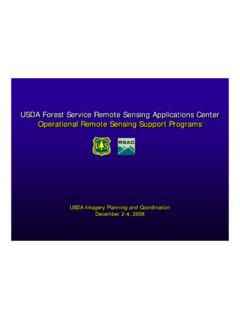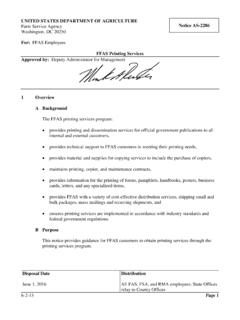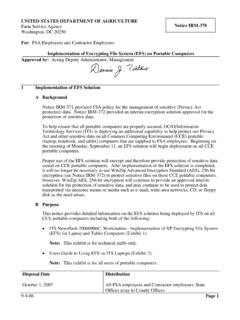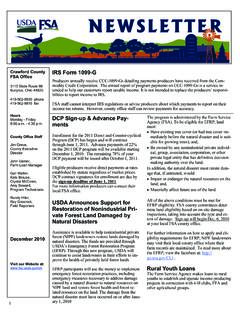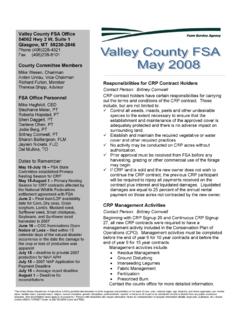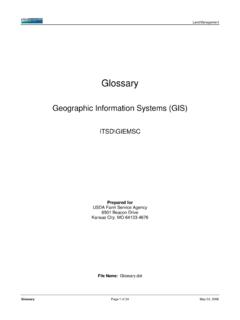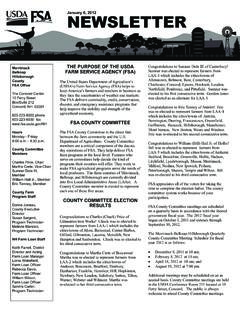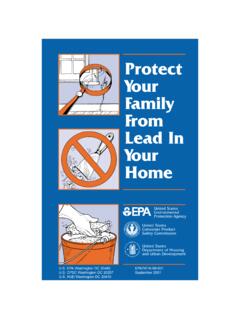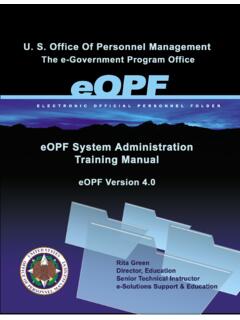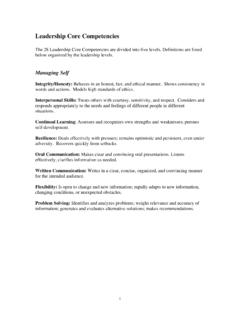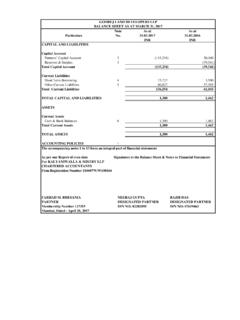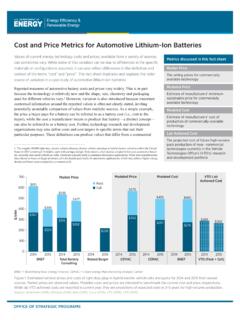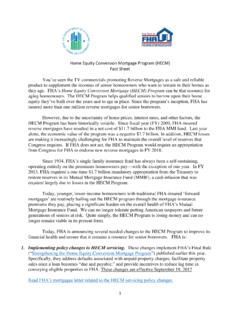Transcription of Farm Service Agency Agriculture Risk Coverage (ARC)
1 OverviewThe Agriculture Improvement Act of 2018 (2018 farm Bill) reauthorized the ARC and PLC programs with modifications for the 2019 through 2023 crop years. The ARC Program is an income support program that provides payments when actual crop revenue declines below a specified guarantee level. The PLC Program provides income support payments when the effective price for a covered commodity falls below its effective reference price. There are 22 covered commodities: wheat, oats, barley, corn, grain sorghum, long grain rice, medium/short grain rice, temperate japonica rice, seed cotton, dry peas, lentils, large and small chickpeas soybeans, peanuts, sunflower seed, canola, flaxseed, mustard seed, rapeseed, safflower, crambe, and sesame It WorksReference PricesPublished Reference Prices for all covered commodities are provided in the table below. Under the 2018 farm Bill amendments, effective reference prices will be calculated to allow upward fluctuation of reference prices in time periods when historic price averages are higher than the established reference price for the covered SHEETA ugust 2019 farm Service AgencyAgriculture Risk Coverage (ARC)& Price Loss Coverage (PLC)1/ Barley price is based on the price of all barley.
2 Previously the price was based on the feed barley Seed cotton price is a weighted average of upland cotton and cottonseed prices. Marketing year for upland cotton is August 1 to July 31. Marketing year for cotton-seed is August 1 to February 1/Chickpeas, Large(Garbanzo bean, Kabuli)Chickpeas, Small(Garbanzo bean, Desi)CornDry PeasGrain SorghumLentilsOatsCanolaCrambeFlaxseedMu stardRapeseedSafflowerSesame SeedSunflowerPeanutsRice, Long GrainRice, Medium/Short GrainRice, Temperate JaponicaSoybeansWheatSeed Cotton 2/$ per bu.$ per cwt$ per cwt$ per bu$ per cwt$ per bu$ per cwt$ per bu$ per cwt.$ per cwt$ per bu$ per cwt$ per cwt$ per cwt$ per cwt$ per cwt$ per ton$ per cwt$ per cwt$ per cwt$ per bu$ per bu$ per lb$ per bu$ per cwt$ per cwt$ per bu$ per cwt$ per bu$ per cwt$ per bu$ per cwt$ per cwt$ per bu$ per cwt$ per cwt$ per cwt$ per cwt$ per cwt$ per ton$ per cwt$ per cwt$ per cwt$ per bu$ per per lbReferencePriceNationalLoanRateEligibil ityBase acres on farms where all cropland acres have been planted entirely to grass or pasture; including cropland that was idle or fallow, from January 1, 2009 through December 31, 2017, will be maintained, but no ARC or PLC payments will be issued for those base acres from 2019 through 2023.
3 Reconstitutions are not permitted to void or change this treatment of base acres. Unassigned base acres resulting from the 2018 allocation of generic base acres are ineligible for payment. Payment acres under ARC-CO and PLC are equal to 85% of the specific covered commodity base acres. For ARC-IC, payment acres are 65% of the farm s total covered commodity base acres. A producer is not eligible to receive ARCPLC payments if the sum of base acres on ALL farms in which the producer has a share is 10 acres or less. This 10-acre rule will not apply to a socially disadvantaged, beginning, veteran, or limited resource farmer or rancher. Yield UpdateOwners will have a 1-time opportunity in 2020 to update PLC yields of covered commodity base crops on their farm , regardless of program election. The updated yield will be equal to 90% of the producer s average yield per planted acre in crop years 2013-2017, subject to the ratio obtained by dividing the 2008-2012 average national yield by the 2013-2017 average national yield for the covered commodity.
4 If the reported yield in any year is less than 75% of the 2013-2017 average county yield, then the yield will be substituted with 75% of the county average yield. 2 ARC-PLC PROGRAM - AUGUST 2019 ElectionAll farm producers with interest in the cropland must make a unanimous election in 2019 of either ARC-CO or PLC on a crop-by-crop basis; or ARC-IC for all covered commodity base acres on a farm . This election will apply to the farm for 2019 through 2023. Program election changes are permitted in crop years 2021, 2022 and 2023. Failure to make a valid election in 2019 will result in a continuation of the program elected for 2014 through 2018 crop years for all covered commodities with base acres on the farm ; and 2019 payments for those unelected covered commodities are be eligible for payments, producers must annually enroll their respective share interest of covered commodity base acres. For 2019 and subsequent years, enrollment will occur on a covered commodity-by-covered commodity base acre crop basis.
5 Enrolling less than 100% of a covered commodity s base acres on a farm is not allowed. Program election and enrollment for program year 2019 will begin September 3, 2019, and will continue to March 15, 2020. Enrollment for program year 2020, following a valid election being performed on the farm for 2019, will begin October 7, 2019, and will continue to June 30, 2020. Enrollment dates for subsequent years will be as determined and announced by FSA. Enrollment for program year 2020 will always follow the valid election (or default election) for 2019. A valid election being made or changed after a 2020 enrollment will invalidate the 2020 enrollment and require 2020 producers to reenroll the farm . RMA s SCO and STAXE lection and enrollment can impact eligibility for some forms of crop insurance. Producers who elect and enroll in PLC also have the option of purchasing Supplemental Coverage Option (SCO) which has been referred to as shallow loss Coverage through the USDA Risk Management Agency (RMA).
6 Producers of covered commodities who elect ARC are ineligible for SCO on their planted acres. Producers of upland cotton who choose to enroll seed cotton base acres in ARC or PLC are ineligible for the stacked income protection plan (STAX) on their planted cotton acres. To be eligible for STAX Coverage , producers must not enroll their seed cotton base acres into the ARCPLC program. Because enrollment is now completed on a commodity-by-commodity basis, producers can choose to enroll all base acres, with the exception of cotton, if they wish to purchase STAX Coverage . Those producers who do enroll in ARCPLC for seed cotton will have their STAX eligibility determined based on that enrollment. Payment SchedulePayments for PLC, ARC-CO and ARC-IC, if triggered, will be issued after October 1 of the year following the program Loss Coverage (PLC)PLC program payments are issued when the effective price of a covered commodity is less than the respective effective reference price for that commodity.
7 The effective price equals the higher of the national market year average price (MYA) or the national average loan rate for the covered commodity. The effective reference price is the lesser of 115% of the reference price or an amount equal to the greater of the reference price or 85% of the average of MYA prices from the 5 preceding years, excluding the highest and lowest price. This new method of calculating the PLC payment rates will allow the effective reference price to be greater than the statutory reference price if the historic average of MYA prices is greater than the statutory reference payments are not dependent upon the planting of a covered commodity or planting of the applicable base crop on the farm . PLC payments, if triggered, will be paid on 85% of the farm s base acres of each covered commodity with a PLC election where the farm has been enrolled. Payment will be issued after the end of the marketing year of the covered commodity, but not before October 1 of the year following the program Agriculture Risk Coverage (ARC-CO)ARC-CO program payments are triggered when the actual county crop revenue of a covered commodity is less than the ARC-CO guarantee for the crop.
8 The actual county revenue and the revenue guarantee are based on county level yield data for the physical location of the base acres on the farm and tract. ARC-CO payments are not dependent upon the planting of a covered commodity or planting of the applicable base crop on the farm . The ARC-CO benchmark revenue is the 5-year Olympic average MYA price multiplied by the 5-year Olympic average county yield. Benchmark yields and MYA s will be calculated using the 5 years preceding the year prior to the program year. The ARC-CO guarantee is determined by multiplying the ARC-CO benchmark revenue by 86%. The ARC-CO actual crop revenue is determined by multiplying the applicable actual county yield by the MYA price for the program year. County yields for the benchmark and actual revenues will be based on the physical location and historical irrigated percentage of base acres on the farm and tract. If a farm has base acres physically located in more than one county or has a historical irrigated percentage for the covered commodity, the benchmark and actual crop revenues will be weighted and summarized based on those aspects to the farm ARC-CO payment is equal to 85% of the base acres of the covered commodity multiplied by the difference between the county guarantee and the actual county crop revenue for the covered commodity.
9 Payment rates may not exceed 10% of the ARC-CO benchmark Agriculture Risk Coverage (ARC-IC)ARC-IC program payments are issued when the actual individual crop revenue for all covered commodities planted on the ARC-IC farm is less than the ARC-IC guarantee for those covered commodities. ARC-IC uses producer s certified yields, rather than county level yields. ARC-IC payments are dependent upon the planting of covered commodities on the farm . A producer s ARC-IC farm is defined as the sum of the producer s interest in all ARC-IC enrolled farms in the state. The farm s ARC-IC guarantee equals 86% of the ARC-IC farm s weighted benchmark revenue. The ARC-IC benchmark revenue is the 5-year Olympic average revenue, which is the MYA price multiplied by the individual s certified yield for each year in the benchmark period. A benchmark revenue is calculated for each planted covered commodity on the ARC-IC farm in the current year, weighed and summed across all covered commodities on the farm .
10 The yields and MYA prices used in the benchmark calculation will be the 5 years preceding the year prior to the program ARC-IC actual crop revenue is determined by multiplying the MYA price by the individual s certified yield, weighted and summed across all covered commodities planted on the farm in the current year. The ARC-IC payment is equal to 65% of the total base acres on the farm , multiplied by the difference between the calculated individual guarantee revenue and the actual individual crop revenue summed across all covered commodities planted on the farm . ARC-IC payment rates may not exceed 10% of the individual weighted benchmark InformationFor more information on FSA programs, eligibility and related information, visit your Local USDA Service CenterTo locate your local FSA office, visit acres on farms where all cropland acres have been planted entirely to grass or pasture; including cropland that was idle or fallow, from January 1, 2009 through December 31, 2017, will be maintained, but no ARC or PLC payments will be issued for those base acres from 2019 through 2023.
